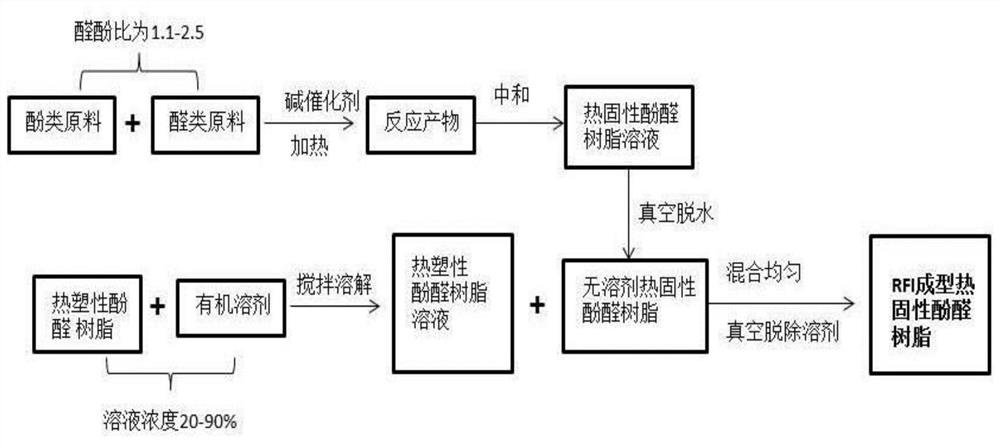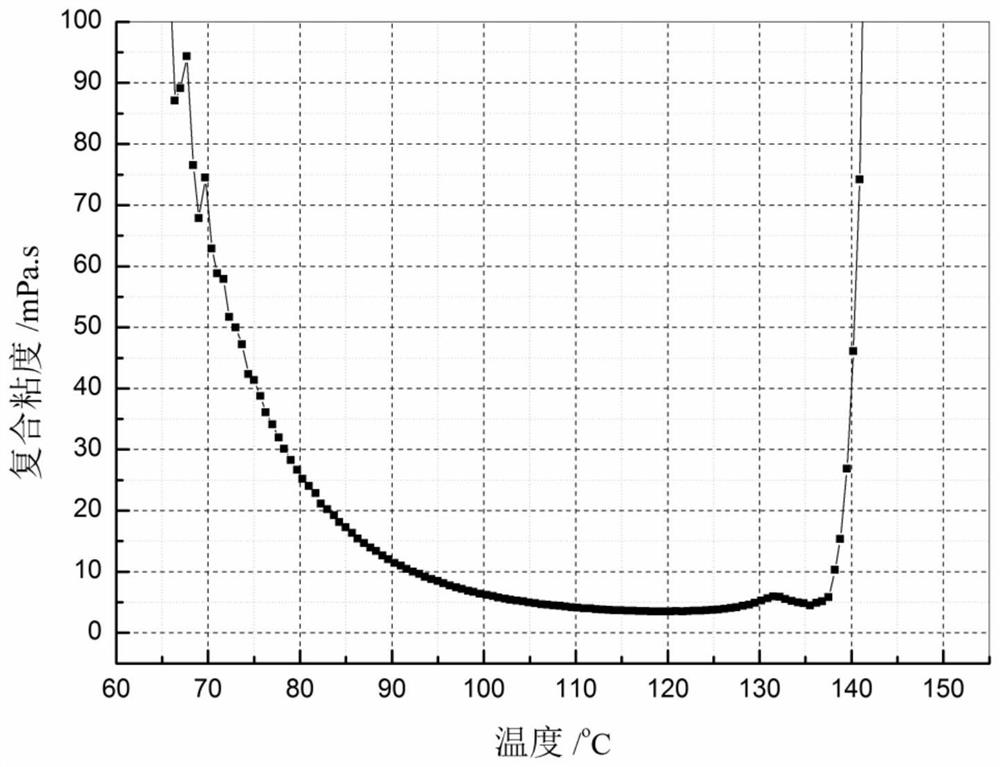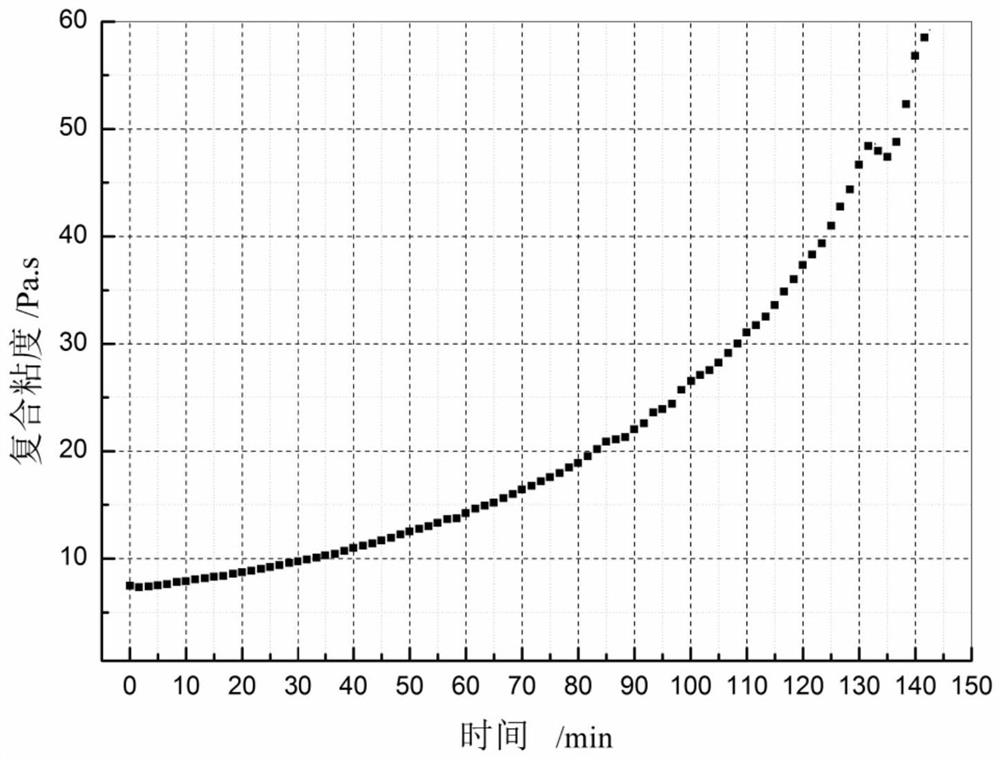A kind of modified phenolic resin and its preparation method and application
A phenolic resin and modification technology, applied in the field of modified phenolic resin and its preparation, can solve the problem of reducing the thermal stability, residual carbon rate and flame retardant performance of the resin, reducing the thermal stability and flame retardant performance of the resin, and reducing the resin process performance. Deterioration and other problems, to shorten the gel time, increase the absolute molecular weight, and improve the effect of film-forming
- Summary
- Abstract
- Description
- Claims
- Application Information
AI Technical Summary
Problems solved by technology
Method used
Image
Examples
Embodiment 1
[0061] Example 1 Preparation of RFI resin (RFI-10) with a thermoplastic phenolic resin content of 10%
[0062] (1) 30L reactor is preheated to 30 ℃, 9.5 kilograms of melted phenol and 11.2 kilograms of 37.5% aqueous formaldehyde are added to above-mentioned reactor, after stirring, add 95 grams of ammoniacal liquor, while stirring, heat up, When the temperature reached 65°C, the reaction was maintained for 0.5 hours. At a speed of 2°C / min, the temperature of the reactor was raised to 80°C, and the reaction was further incubated at 80±1°C for 2 hours. The temperature of the reaction kettle was further heated up to 95°C at a rate of 2°C / min, and the reaction was kept at 95±1°C for 0.5 hours, and the addition condensation reaction stage was completed.
[0063] Cool the reactor material to 50°C, add hydrochloric acid to neutralize to pH 4.0.
[0064] Reheat the material. When the temperature of the material rises to 55°C, vacuum dehydration begins. After most of the water in the...
Embodiment 2
[0070] Example 2 Preparation of RFI resin (RFI-20) with a thermoplastic phenolic resin content of 20%
[0071] (1) 30L reactor is preheated to 30 ℃, 9.5 kilograms of phenol after melting and 8.8 kilograms of 37.5% formaldehyde solution are added in above-mentioned reactor, after stirring, add 475 grams of barium hydroxide, while stirring, The temperature was raised, and when the temperature reached 65°C, the reaction was maintained for 0.5 hours. At a speed of 2°C / min, the temperature of the reactor was raised to 85°C, and the reaction was further incubated at 80±1°C for 1 hour. The temperature of the reaction kettle was further heated up to reflux at a rate of 2°C / min, and the reaction was carried out for 1.0 hours, and the addition condensation reaction stage was completed.
[0072] Cool the reactor material to 50°C, add phosphoric acid to neutralize to pH 7.5, and filter to remove the precipitate.
[0073] Reheat the material. When the temperature of the material rises to...
Embodiment 3
[0080]Example 3 Preparation of RFI resin (RFI-30) with a thermoplastic phenolic resin content of 30%
[0081] (1) reactor is preheated to 30 ℃, 7.6 kilograms of phenol after melting, 545 grams of m-cresol, 735.4 grams of naphthol, 1.7 kilograms of 3-phenylphenol and 20 kilograms of aqueous formaldehyde solution of 37.5% are added to above-mentioned reaction In the kettle, after stirring evenly, 317.7 g of sodium hydroxide was added, and the temperature was raised while stirring. When the temperature reached 65° C., the reaction was incubated for 1 hour. At a speed of 2°C / min, the temperature of the reactor was raised to 80°C, and the reaction was further incubated at 80±1°C for 1 hour. The temperature of the reactor was further heated up to 85±1°C at a rate of 2°C / min, and the reaction was carried out for 2.0 hours, and the addition condensation reaction stage was completed.
[0082] Cool the reactor material to 50°C, add hydrochloric acid to neutralize to pH 5.0.
[0083] R...
PUM
| Property | Measurement | Unit |
|---|---|---|
| viscosity | aaaaa | aaaaa |
| gel time | aaaaa | aaaaa |
| viscosity | aaaaa | aaaaa |
Abstract
Description
Claims
Application Information
 Login to View More
Login to View More - R&D
- Intellectual Property
- Life Sciences
- Materials
- Tech Scout
- Unparalleled Data Quality
- Higher Quality Content
- 60% Fewer Hallucinations
Browse by: Latest US Patents, China's latest patents, Technical Efficacy Thesaurus, Application Domain, Technology Topic, Popular Technical Reports.
© 2025 PatSnap. All rights reserved.Legal|Privacy policy|Modern Slavery Act Transparency Statement|Sitemap|About US| Contact US: help@patsnap.com



